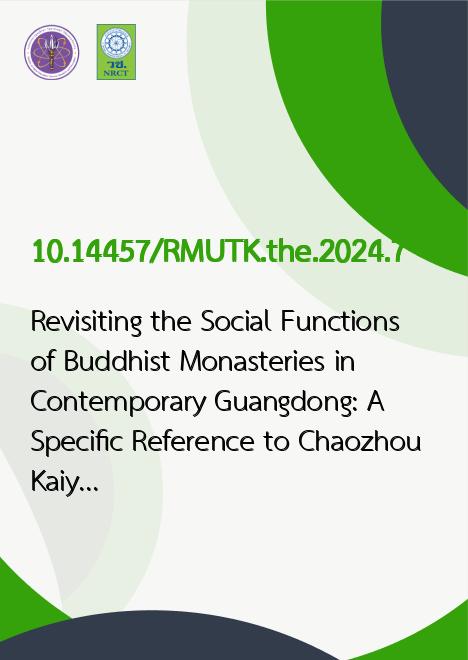
|
Revisiting the Social Functions of Buddhist Monasteries in Contemporary Guangdong: A Specific Reference to Chaozhou Kaiyuan Si |
|---|---|
| รหัสดีโอไอ | |
| Title | Revisiting the Social Functions of Buddhist Monasteries in Contemporary Guangdong: A Specific Reference to Chaozhou Kaiyuan Si |
| Creator | Zheng, Dongxiao |
| Contributor | LIU,Yaoping, advisor |
| Publisher | Rajamangala University of Technology Krungthep |
| Publication Year | 2567 |
| Keyword | Buddhist temple, Buddhism, Public diplomacy, Chaozhou Kaiyuan Si |
| Abstract | Buddhist monasteries in China have historically fulfilled four mainfunctions: spirituality, education, charity, and culture. These functions have variedsignificantly over time and have been influenced by changing sociopolitical contexts.While existing scholarship has explored the societal roles of these monasteries, lessattention has been given to the fluid and dynamic interplay between these functions.Moreover, the extent to which certain monasteries emphasized specific roles due totheir strategic location remains understudied. This study examines the contemporaryfunctions of Buddhist monasteries in Guangdong Province, focusing on Kaiyuan Si(Monastery of the Kaiyuan Era) in Chaozhou. Fieldwork was conducted from March toMay 2023, including participation in religious observances and ceremonies. Surveys of100 laypersons attending monastery programs assessed religiosity, while in-depthinterviews with five senior residential monks, two of whom oversee the monastery'scharity foundation, provided further insights. Archival materials and unpublishedmemoirs were also reviewed. Findings indicate that Kaiyuan Si operates as more thana religious center. Its educational programs, emphasizing Buddhist philosophy andtraditional Chinese arts, overshadow its spiritual role. A notable feature is a ThaiBuddhist temple adjacent to Kaiyuan Si, modeled after Bangkok's WatBenchamabophit Dusit Wanaram. Donated by Thai-Chinese tycoon Mr. PrichaPhisittkasem (Xie Huiru, 1913–1997) to honor his ancestors, this temple symbolizesChinese-Thai cultural exchange. However, its presence also serves as a tool for China'spublic diplomacy with Thailand. This study argues that long-standing Buddhistmonasteries in China, such as Kaiyuan Si, increasingly adopt secular roles. Theiractivities and architectural designs align with traditional Chinese culture, reflecting ashift from religious to cultural and diplomatic functions. These findings highlight howBuddhist monasteries in contemporary China are recontextualized within broadercultural and geopolitical frameworks. |
| Language | en |
| URL Website | https://dspace.rmutk.ac.th/ |